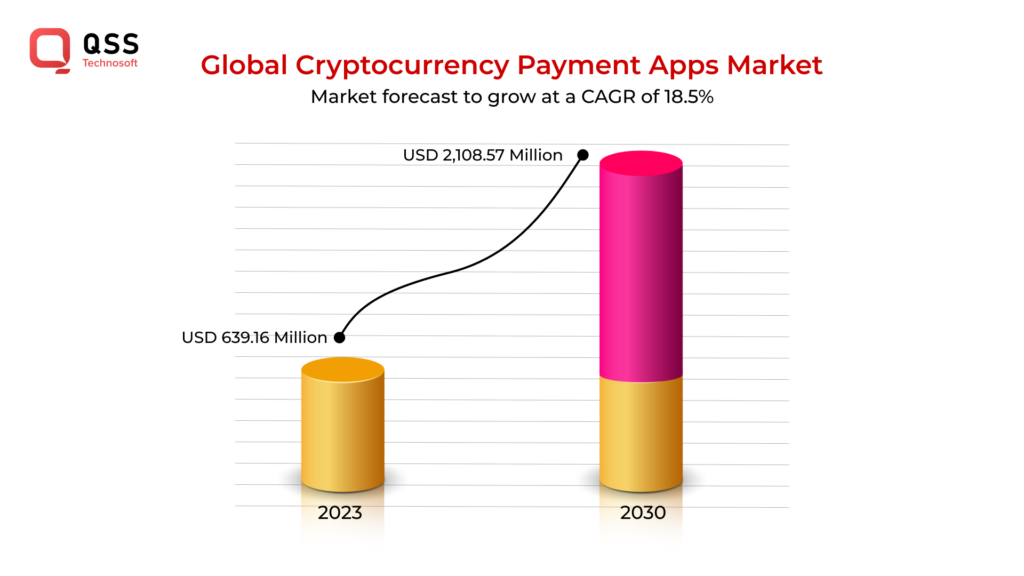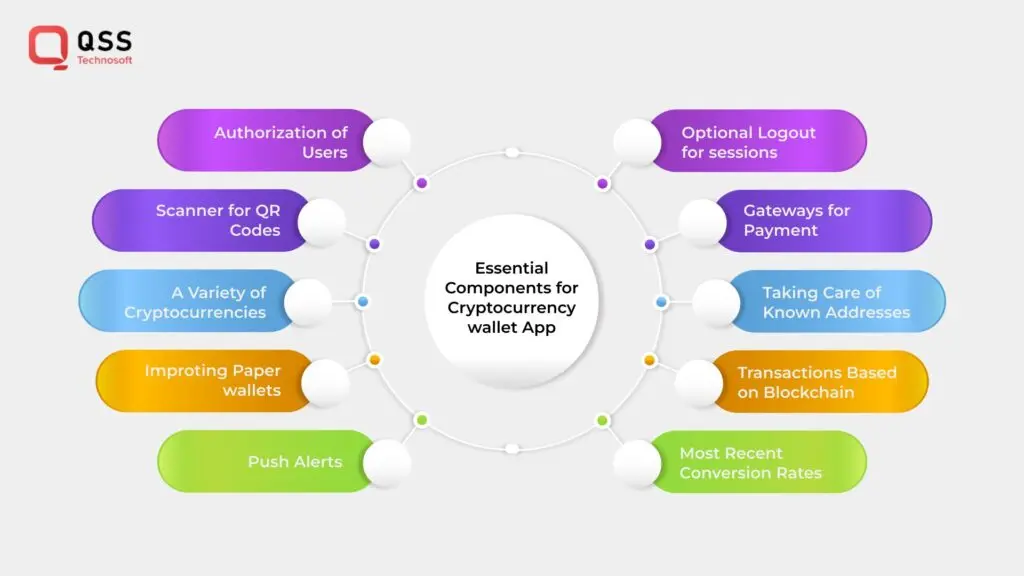Cryptocurrencies are the new talk of the market these days. With the global market revenue exceeding $3 trillion, digital currencies will be widely accepted in 2024 & beyond. Major financial institutions and government offices are joining the race to build their own cryptocurrency. Further innovations in blockchain technology, decentralized finance (DeFi), and non-fungible tokens (NFTs) are offering new opportunities and investments with digital currencies and wallets. As per the latest study,
“By 2030, the Global Cryptocurrency Payment Apps market is projected to reach over $2.108 million, growing at a CAGR of 18.52% over the next 8 years (Research and Markets).”

If your business primarily deals with financial transactions, then it’s high time to embrace the benefits of this fabulous technology. By introducing your own digital currencies and implementing a secure, highly scalable cryptocurrency wallet, you can significantly grow and future-proof your business.
In this guide, we will provide a comprehensive, step-by-step development procedure of cryptocurrency wallet in 2024. Whether you’re a blockchain developer, an enterprise or a startup entrepreneur looking to enter the crypto market, this guide will equip you with necessary tools to create a secure, efficient, and user-friendly crypto wallet. So, let’s get started!
Read also:- How to build an app like Atomic cryptocurrency wallet?
Why Cryptocurrency Wallet Development
Cryptocurrency wallets are the backbone of the crypto ecosystem. Just as you use a wallet to securely store your cash, you need a secure crypto wallet to keep your digital currencies safe. Without wallets, there would be no use of digital currency. Go through the reasons why cryptocurrency wallets are essential:
- Security: A crypto wallet protects users’ private keys needed to access and manage their cryptocurrencies. Advanced crypto wallet security features like encryption, multi-signature support, and biometric authentication ensure the safety of digital assets.
- Accessibility: These wallets help users to interact with their cryptocurrencies like – sending, receiving, and tracking your transactions.
- Multi- Functionality: Modern wallets come with more advanced features like- DeFi protocols, staking, trading NFTs that allow users to further engage into crypto space.
- Interoperability: Wallets support multiple cryptocurrencies to help users manage diverse portfolios from a single application.
Types of Cryptocurrency Wallets
Cryptocurrency wallets come in various types, fulfilling different needs & levels of security for users:

Hot Wallets: Most user-friendly wallets with an internet connection for frequent transactions. Examples of some hot wallets include mobile wallets and web wallets.
Cold Wallets: Good for long-term storage of cryptocurrencies. These are offline and offer enhanced crypto wallet security. Some cold wallets are- hardware wallets & paper wallets.
Software Wallets: These are more like apps that are installed on a device like a smartphone, desktop, or browser extension. For eg- Trust Wallet (mobile) and MetaMask (browser extension).
Hardware Wallets: They are more like physical devices that are used to store the user’s private keys offline. Examples include Ledger Nano S and Trezor wallets.
Paper Wallets: These are papers with QR codes containing private and public keys. These are the most secure form of wallets but they can be lost or damaged easily.
Essential Components of a Cryptocurrency Wallet
You need to know about the core components of a cryptocurrency wallet before starting to build one. Here are the main elements:
Private & Public Keys
A private key consists of a secret number that offers access to the owner to manage their cryptocurrency. As the name suggests, it is highly confidential and should not be shared. On the other hand, a public key is derived from the private key that can be shared openly to others to send cryptocurrency to the wallet.
Wallet Address
The most unique wallet address with alphanumeric characters derived from the public key- more like an account number.
Seed Phrases
Seed phrase or recovery phrase component can be used to recover the wallet if the device is lost or damaged.
User Interface (UI)
The part of wallet visible to you digitally. It allows users to interact with their funds- view balances, send and receive cryptocurrency, and manage wallet settings.
Security Features
A cryptocurrency wallet includes advanced security features such as two-factor authentication (2FA), biometric authentication, and multi-signature support. This prevents unauthorized access.
Some Popular Cryptocurrency Wallets in the Market
Before you consider building the best crypto wallet, have a look at some of the popular wallets available in the market:
Exodus
Exodus wallet supports multiple cryptocurrencies that users can exchange directly within the wallet.
Atomic Wallet
Known to support over 500 cryptocurrencies, this wallet stores private keys enabling peer-to-peer trading without intermediaries.
Trezor
A type of hardware wallet offering top-notch security for storing cryptocurrencies offline. It supports a wide range of digital assets.
Mycelium
Mycelium offers support for Bitcoin and Ethereum offering features like hardware wallet support, local trader (a peer-to-peer trading platform), and cold storage options.
MetaMask
MetaMask is widely used for interacting with the Ethereum blockchain. It’s available as both a browser extension and a mobile app, making it convenient for accessing decentralized applications (dApps).
Blockchain Wallet
Developed by Blockchain.com, this wallet supports Bitcoin, Ethereum, and other major cryptocurrencies.
Let’s Plan To Develop Your Cryptocurrency Wallet
Identify Your Target Audience
Identifying your target users is the first step before you start building your wallet. Is your wallet for everyday users, businesses, or crypto traders?
Decide which Type of Wallet You want to Build
Choose the type of wallet that best suits your target audience:
- Mobile Wallets: Convenient for everyday transactions.
- Desktop Wallets: Offer robust features for advanced users.
- Web Wallets: Accessible from any device with internet.
- Hardware Wallets: Provide the highest security for long-term storage.
Define Features Your Wallet will Offer
Determine the primary features your wallet will offer, some include:
- Multi-Currency Support
- Security Features like two-factor authentication, and biometric authentication.
- Intuitive UI/UX
- Cloud Backup to allow storage & easy recovery.
- Transaction Functionalities for users
- Integration with Exchange Integration to allow in-app trading and dApps support for interactions with decentralized applications.

Technology Stack for Building a Cryptocurrency Wallet
Choosing the Right Programming Languages:
- JavaScript: Ideal for web and mobile apps.
- Python: Great for backend services.
- Swift/Kotlin: For iOS and Android app development.
Blockchain Platform Compatibility:
Ensure your wallet supports major blockchain platforms like:
- Bitcoin
- Ethereum
- Binance Smart Chain
Tools and Frameworks:
Utilize the right tools and frameworks for efficient development:
- Web3.js/Ether.js: For interacting with Ethereum.
- BitcoinJS: For Bitcoin-related development.
Step- By Step Cryptocurrency Wallet Development Process
Step 1: Setting Up the Development Environment
In the very first step of cryptocurrency wallet development, you need to prepare your development environment with necessary tools and libraries:
Install Integrated Development Environments (IDEs) like:
- Visual Studio Code
- PyCharm
Set Up Blockchain Nodes
- Connect to Testnets like Ropsten or Rinkeby (Ethereum) and Testnet3 (Bitcoin) to develop and test without using real tokens.
- Install Node Software like Geth for Ethereum or Bitcoin Core for Bitcoin.
- Sync with the Testnet
- Obtain Test Tokens. You can use faucets to get free test tokens.
Install Necessary Libraries and Frameworks like
- Web3.js for interacting with the Ethereum blockchain.
- BitcoinJS to work with Bitcoin transactions and addresses.
- Ether.js as a lightweight alternative to Web3.js.
Step 2: Designing the Wallet Architecture
In the 2nd step, you must plan the architecture focusing on scalability and security:
Front-End
- Responsive Design for a seamless user experience across devices.
- Prioritize user-friendly navigation and clean design
- Ensure dynamic and interactive user interfaces (Tip: Make use of popular frameworks like React, Angular, or Vue.js)
Back-End
- Secure Transaction handling by implementing robust mechanisms
- Seamless communication between the front-end and back-end. (Tip: Use RESTful APIs or GraphQL to handle this)
- Safeguard user data with strong encryption methods and ensure compliance with data privacy regulations.
- Ensure encryption using AES (Advanced Encryption Standard) to protect sensitive information.
Database
- Facilitate secure storage for transaction data and user information, ensuring data integrity and confidentiality.
- Consider using SQL databases like PostgreSQL for structured data or NoSQL databases like MongoDB for flexible storage.
- Implement regular backup and recovery processes to prevent data loss and quick restoration.
Step 3: Implementing Core Functionalities
It’s time to develop the main features of the wallet:
Wallet Creation
- Key Generation: Develop functionality to generate private/public key pairs. For this you can use cryptographic libraries like OpenSSL or Web3.js.
Key Management
- Secure Storage: Implement secure methods to store private keys, such as encrypted local storage or hardware security modules. Protect keys using strong encryption algorithms like AES-256.
- Backup Solutions: Provide users with secure backup and recovery options, like seed phrases or encrypted backups.
Transaction Processing
- Sending Cryptocurrencies: Enable users to send cryptocurrencies with clear transaction confirmation steps. For this, you can utilize blockchain APIs for broadcasting transactions.
- Receiving Cryptocurrencies: Ensure the wallet can generate and display new receiving addresses for incoming transactions. Implement QR code generation for easy address sharing.
- Transaction History: Maintain a detailed transaction history for users to track their transfers. Integrate a secure and efficient database to store transaction details.
Step 4: Ensuring Security Throughout the Development
Adopt best practices to maintain high security standards:
- Adopt best practices to prevent common vulnerabilities such as SQL injection, cross-site scripting (XSS), and buffer overflows.
- Implement peer code reviews to catch potential security issues early. Use static code analysis tools to automatically detect vulnerabilities.
- Conduct frequent security reviews through Internal & External Audits throughout the development lifecycle.
- Perform penetration testing to identify and fix security weaknesses. Use tools like Metasploit, Burp Suite, and Nessus for thorough security testing.
Step 5: Rigorous Testing to Detect & Fix Issues
Ensure comprehensive testing to identify and resolve issues:
Unit Testing
- Test individual components for correctness. For this, you can use tools: Mocha, Chai, Jest for JavaScript testing.
- Proceed with Integration Testing to verify that multiple components work together seamlessly.
Security Testing
- Identify and fix vulnerabilities using penetration testing & vulnerability scanning to ensure the wallet’s security.
User Acceptance Testing (UAT)
- This testing is done to check if the product meets user expectations and requirements. Tip: Conduct testing sessions with real users to gather feedback.
Tools for Testing Cryptocurrency Wallets
Utilize the right tools to streamline testing:
- Mocha/Chai/Jest: Ideal for JavaScript testing, providing a robust framework for unit and integration tests.
- Selenium: For automated web application testing, ensuring comprehensive coverage of the user interface.
Step 6: Deployment and Maintenance
Yay, it’s time to deploy your wallet!! Follow these steps for deploying and maintaining a cryptocurrency wallet:
- Setting Up Servers: Use reliable and secure servers to host your wallet.
- Domain and SSL Certificates: Use a reputable domain and SSL certificates to secure your website.
Step 7: Monitoring and Maintaining the Wallet
The last step is to keep your wallet running smoothly post-launch:
Monitoring and Maintaining the Wallet
- Regularly updates the wallet with the latest security patches and feature enhancements.
- Address any bugs or security vulnerabilities by implementing a robust mo
- Ephemeral Messaging
- nitoring system.
Gathering User Feedback and Improving the Wallet
- Conduct surveys or direct feedback forms and continuously improve the wallet based on user experiences and feedback.
- Enhance user satisfaction by using feedback to develop new features and improvements.
Read also:- How to Build an App like Trezor Cryptocurrency Wallet?
Conclusion
The cryptocurrency market is growing rapidly and building your cryptocurrency wallet can help you capitalize on this dynamic industry and position yourself at the forefront of digital finance.
As the Cryptocurrency wallet development market continues to evolve, embracing this will contribute to the future of digital finance and meet the demands of an ever-expanding Finance market.
QSS Technosoft is a leading name in offering comprehensive cryptocurrency wallet development services for over a decade. Our Blockchain developers’ team leverages the latest technologies in blockchain, to deliver robust and user-friendly wallets. QSS is proficient in creating innovative and secure cryptocurrency solutions that stand out in today’s competitive market.
We are proud to mention that our work has been recognized by leading B2B reviews and research platforms like GoodFirms, Clutch, MirrorView, and many more.


Everything You Need to Know About Building a Cryptocurrency Wallet in 2024